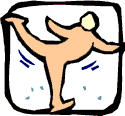 | Helmets for Ice Skaters? |  |
 | Helmets for Ice Skaters? |  |
 July 19, 2004
July 19, 2004HELMETS: skateboarders, rollerskaters, in-line skaters, skiers and snowboarders wear them. Should ice skaters be added to the list? Researchers, led by Jennifer McGeehan in the Department of Pediatrics at The Ohio State University, think so.
Most skateboarding injuries occurred to the arms and hands (14 of 44
cases; 32.8%) and legs (11 of 44 cases; 25.1%). Head injuries accounted
for 7 of 44 (15.9%) of the skateboarding injuries. The age pattern of
skateboarders' head and face injuries was similar to that of ice-skaters'
head injuries: children younger than 6 years old had more frequent head
injuries (5 of 8 cases; 62.5%) than older children (12 of 36 cases; 33.3%
). Rollerskating and in-line skating injuries most frequently involved the legs and arms. Only 13 of 131 (9.9%) rollerskating injuries and 9 of 184 (4.9%) in-line skating injuries involved the head. These data show that ice-skaters sustain more frequent injuries to the head than skateboarders, in-line skaters and rollerskaters. The researchers suggest that ice-skaters (and skateboarders) may fall differently than rollerskaters and in-line skaters. Rollerskaters and in-line skaters appear to fall forward and try to protect themselves by falling on their arms. Ice-skaters and skateboarders may fall sideways or backwards and therefore, injure their heads. Young children may be at a higher risk for head injuries because they have a higher center of gravity and fall over headfirst. Also, the researchers state that young children may not have the arm strength to stop themselves to avoid a head injury when they fall. Because of the high proportion of head injuries among ice-skaters, the researchers conclude:
|
Did you know? | New York State Assembly Bill A06770 would create a law that would require children under the age of 14 years to wear helmets while ice-skating. (New York State Law already requires that children younger than 14 years must wear helmets while riding a bicycle, using in-line skates and playing ice hockey.) |
| Reference and
further information:
|
| GO TO: | Neuroscience In The News | Explore the Nervous System | Table of Contents |
![[email]](./gif/menue.gif) Send E-mail |
 Fill out survey |
 Get Newsletter |
 Search Pages |
 Take Notes |